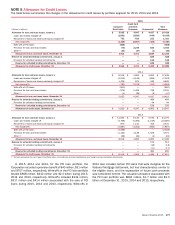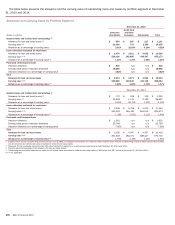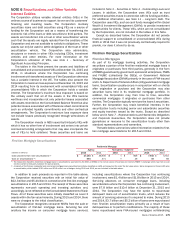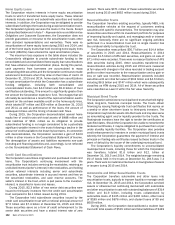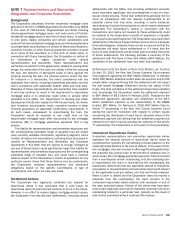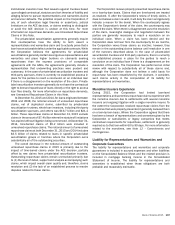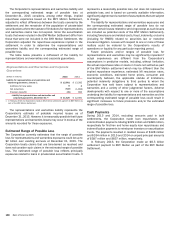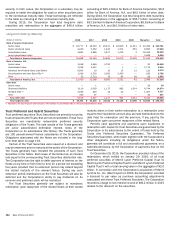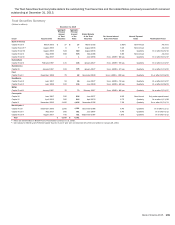Bank of America 2015 Annual Report Download - page 189
Download and view the complete annual report
Please find page 189 of the 2015 Bank of America annual report below. You can navigate through the pages in the report by either clicking on the pages listed below, or by using the keyword search tool below to find specific information within the annual report.Bank of America 2015 187
institutional investors have filed lawsuits against trustees based
upon alleged contractual, statutory and tort theories of liability and
alleging failure to pursue representations and warranties claims
and servicer defaults. The potential impact on the Corporation, if
any, of such alternative legal theories or assertions, judicial
limitations on the ACE decision, or claims seeking to distinguish
or avoid the ACE decision is unclear at this time. For more
information on repurchase demands, see Unresolved Repurchase
Claims in this Note.
The private-label securitization agreements generally require
that counterparties have the ability to both assert a
representations and warranties claim and to actually prove that a
loan has an actionable defect under the applicable contracts. While
the Corporation believes the agreements for private-label
securitizations generally contain less rigorous representations and
warranties and place higher burdens on claimants seeking
repurchases than the express provisions of comparable
agreements with the GSEs, the agreements generally include a
representation that underwriting practices were prudent and
customary. In the case of private-label securitization trustees and
third-party sponsors, there is currently no established process in
place for the parties to reach a conclusion on an individual loan
if there is a disagreement on the resolution of the claim. Private-
label securitization investors generally do not have the contractual
right to demand repurchase of loans directly or the right to access
loan files directly. For more information on repurchase demands,
see Unresolved Repurchase Claims in this Note.
At December 31, 2015 and 2014, for loans originated between
2004 and 2008, the notional amount of unresolved repurchase
claims, net of duplicated claims, submitted by private-label
securitization trustees, whole-loan investors, including third-party
securitization sponsors, and others was $16.7 billion and $21.2
billion. These repurchase claims at December 31, 2015 exclude
claims in the amount of $7.4 billion where the statute of limitations
has expired without litigation being commenced. At December 31,
2014, time-barred claims of $5.2 billion were included in
unresolved repurchase claims. The notional amount of unresolved
repurchase claims at both December 31, 2015 and 2014 includes
$3.5 billion of claims related to loans in specific private-label
securitization groups or tranches where the Corporation owns
substantially all of the outstanding securities.
The overall decrease in the notional amount of outstanding
unresolved repurchase claims in 2015 is primarily due to the
impact of time-barred claims under the ACE decision, partially
offset by new claims from private-label securitization trustees.
Outstanding repurchase claims remain unresolved primarily due
to (1) the level of detail, support and analysis accompanying such
claims, which impact overall claim quality and, therefore, claims
resolution and (2) the lack of an established process to resolve
disputes related to these claims.
The Corporation reviews properly presented repurchase claims
on a loan-by-loan basis. Claims that are time-barred are treated
as resolved. If, after the Corporation’s review of timely claims, it
does not believe a claim is valid, it will deny the claim and generally
indicate a reason for the denial. When the counterparty agrees
with the Corporation’s denial of the claim, the counterparty may
rescind the claim. When there is disagreement as to the resolution
of the claim, meaningful dialogue and negotiation between the
parties are generally necessary to reach a resolution on an
individual claim. When a claim has been denied and the
Corporation does not hear from the counterparty for six months,
the Corporation views these claims as inactive; however, they
remain in the outstanding claims balance until resolution in one
of the manners described above. In the case of private-label
securitization trustees and third-party sponsors, there is currently
no established process in place for the parties to reach a
conclusion on an individual loan if there is a disagreement on the
resolution of the claim. The Corporation has performed an initial
review with respect to substantially all of these claims and,
although the Corporation does not believe a valid basis for
repurchase has been established by the claimant, it considers
such claims activity in the computation of its liability for
representations and warranties.
Monoline Insurers Experience
During 2015, the Corporation had limited loan-level
representations and warranties repurchase claims experience with
the monoline insurers due to settlements with several monoline
insurers and ongoing litigation with a single monoline insurer. To
the extent the Corporation received repurchase claims from the
monolines that were properly presented, it generally reviewed them
on a loan-by-loan basis. Where the Corporation agrees that there
has been a breach of representations and warranties given by the
Corporation or subsidiaries or legacy companies that meets
contractual requirements for repurchase, settlement is generally
reached as to that loan within 60 to 90 days. For more information
related to the monolines, see Note 12 – Commitments and
Contingencies.
Liability for Representations and Warranties and
Corporate Guarantees
The liability for representations and warranties and corporate
guarantees is included in accrued expenses and other liabilities
on the Consolidated Balance Sheet and the related provision is
included in mortgage banking income in the Consolidated
Statement of Income. The liability for representations and
warranties is established when those obligations are both
probable and reasonably estimable.


